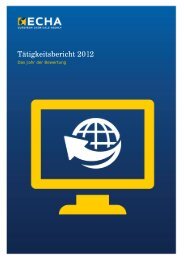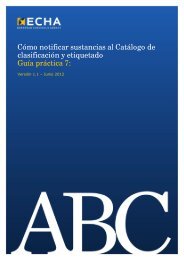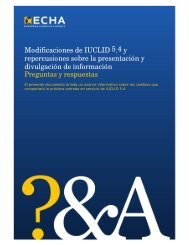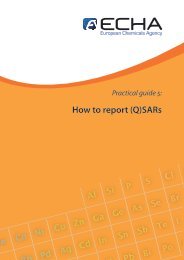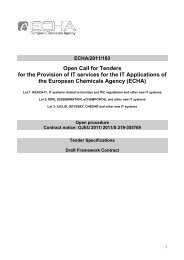Strategy For Limiting Risks Human Health Draft of ... - ECHA - Europa
Strategy For Limiting Risks Human Health Draft of ... - ECHA - Europa
Strategy For Limiting Risks Human Health Draft of ... - ECHA - Europa
You also want an ePaper? Increase the reach of your titles
YUMPU automatically turns print PDFs into web optimized ePapers that Google loves.
Tables 2.6 (inhalation) and 2.7 (dermal contact) intend to visualize the risk pr<strong>of</strong>ile <strong>of</strong> cryolite.<br />
According to the arrangement <strong>of</strong> the tables high risks occur on the left side, low risks on the<br />
right side <strong>of</strong> the table-matrix.<br />
With respect to local effects in the airways after repeated inhalation exposure levels to<br />
cryolite dust should be controlled to values in the range <strong>of</strong> 0.1 mg/m 3 (critical exposure level<br />
for local effects after repeated exposure). In doing so, inhalation risks from other endpoints,<br />
especially adverse effects by fluorosis after long-term exposure (critical exposure level:<br />
1 mg/m 3 ), as well as risks by developmental toxicity (critical exposure level: 6.2 mg/m 3 ) are<br />
similarly and effectively be mitigated too.<br />
Special attention should be given to skin contact. From the risk assessment there is indication<br />
that repeated dermal exposure at the workplace to cryolite dust might contribute to critical<br />
elevated systemic fluoride levels. This could lead to fluorosis and also an elevated cancer risk<br />
cannot fully be ruled out. If it causes severe problems to controll the dermal exposure<br />
situation at the workplace to a level below 1.3 mg/kg/day or 92 mg/person/day (critical<br />
exposure level for fluorosis), a suitable dermal absorption study could give an additional<br />
option to refine the dermal risk estimation and might be taken into consideration.<br />
To prevent adverse health effects by fluorosis according to the WHO (EHC 2002) a total daily<br />
uptake <strong>of</strong> 6 mg F⎯/person should not be exceeded. In this respect cryolite exposure at the<br />
workplace is only one factor among others which might contribute to systemic fluoride<br />
accumulation. To control the different sources for elevated systemic fluoride levels a more<br />
general approach is needed which includes fluoride uptake by working conditions as well as<br />
fluoride exposure <strong>of</strong> the general public by other sources too. This however is no subject <strong>of</strong><br />
this report.<br />
27



